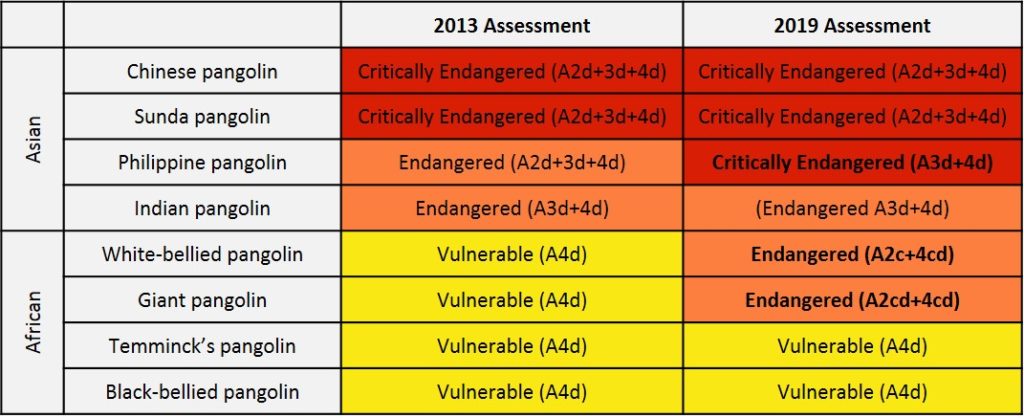 The IUCN Red List of Threatened SpeciesTM (hereafter ‘Red List’) is the planet’s most comprehensive information source on the global status of animal, plant and fungus species. The Red List categorises species according to their extinction risk, which ranges from Least Concern to Extinct. To date, more than 112,000 species have been assessed on the Red List, of which 30,000 are threatened with extinction, meaning they are categorised as Vulnerable, Endangered or Critically Endangered and accordingly face a high, very high, or extremely high risk of extinction in the wild.
The IUCN Red List of Threatened SpeciesTM (hereafter ‘Red List’) is the planet’s most comprehensive information source on the global status of animal, plant and fungus species. The Red List categorises species according to their extinction risk, which ranges from Least Concern to Extinct. To date, more than 112,000 species have been assessed on the Red List, of which 30,000 are threatened with extinction, meaning they are categorised as Vulnerable, Endangered or Critically Endangered and accordingly face a high, very high, or extremely high risk of extinction in the wild.
The Red List contains information on the ecology, distribution, habitat, population status, threats, and the use and trade of species, information that is vital in helping to prioritise conservation action. For example, informing what action is required and where, as well as providing information on research needs to further inform conservation activities.
Twice a year the Red List is updated, which encompasses adding species that have been assessed for the first time and updating assessments for species that have previously been assessed. Where updates occur, species may move into a different Red List category, for genuine or non-genuine reasons. Changes in the status of species for genuine reasons occur where the main threats have continued or increased and/or new threats have emerged, or where the main threats are no longer apparent and/or conservation measures (e.g., harvest management, reintroduction) have led to improvements in the status of species. Changes for non-genuine reasons happen when new information is available (e.g., on population sizes, exploitation rates) which may indicate that the level of threat is more severe than previously thought, or for other reasons, including that underlying threats are better understood, or because there have been changes in taxonomy.
Pangolins on the IUCN Red List
Like many other species, pangolins have been included on the Red List for several years, at least since the Global Mammal Assessment in 1996. In 2013, the Pangolin Specialist Group re-assessed all pangolins for the Red List, which resulted in the Chinese and Sunda pangolins being listed as Critically Endangered, the Philippine and Indian pangolins as Endangered, and the four African species as Vulnerable. Earlier this year, the Pangolin Specialist Group and other experts convened in working groups to assess pangolins for the Red List again.
Since 2013, the profile of pangolins has grown, and much more research and conservation action is happening, meaning there is more knowledge and information on the levels of threat facing the species. In particular, this includes evidence of the developing threat of intercontinental trafficking of African pangolin scales to Asian markets. The 2019 assessments resulted in changes to the Red List categories for three species for non-genuine reasons, taking a precautionary approach. These assessments were informed by greater knowledge of the threat from overexploitation, including its inferred impact on populations, and habitat loss. More detailed information on these changes is presented below.

IUCN Red List categories and the criteria met for each species of pangolin in 2013 and 2019
Giant pangolin: From Vulnerable to Endangered
The giant pangolin (Smutsia gigantea) was categorised as Vulnerable in 2013, but is now categorised as Endangered. The largest species of pangolin, with adults weighing more than 30kg, and possibly up to 40kg, is found in Central and West Africa and is thought to be uncommon and generally rare across its range. The listing of the species as Endangered is based on a decline in area of occupancy and habitat quality over a period of three generations (45 years) and on inferred past and future population declines due to exploitation for local use of its meat and scales, and international trafficking of scales to Asia.
White-bellied pangolin: From Vulnerable to Endangered
The white-bellied pangolin (Phataginus tricuspis) is the most frequently encountered African pangolin and is now categorised as Endangered, having previously been assessed as Vulnerable. This is based on inferred population declines over the past three generations (21 years) based on a combination of forest loss, particularly in West Africa, and increasing rates of exploitation for local use and intercontinental trafficking of scales since around 2008. Estimates suggest that scales from the equivalent of more 500,000 African pangolins were trafficked in recent years (see here), most of which likely comprised white-bellied pangolin scales.
Critically, evidence is emerging that this species (as well as other tropical African pangolins) is increasingly targeted for illicit export of its scales, as opposed to as a by-product of the wild meat trade. It is inferred that populations could decline by up to 50% over a period of three generations looking back one generation and forward two generations (2012-2033).
Philippine pangolin: From Endangered to Critically Endangered
The Philippine pangolin (Manis culionensis) is found only in the Philippines, being endemic to Palawan Island and surrounding islands. It has the smallest range of all pangolin species. This restricted range and likely small population size compared with other pangolin species means it is likely less able to sustain exploitation from illegal hunting and poaching. It is inferred that populations will decline by >80% looking forward three generations (21 years; 2019-2040) and looking backwards one generation and forward two generations (2012-2033) based on overexploitation for domestic and international use and illegal trade, which is compounded by the species’ restricted distribution.

(Left to right) Philippine pangolin by Roger Dolorosa, Giant pangolin by the Tanzania Carnivore Program, and White-bellied pangolin by Guy Colborne
The other five species
Reassessment of the other species of pangolin has not resulted in changes to their Red List category, but the assessments have been revised with up to date knowledge and information on habitats, distribution, use and trade, and among others, essential conservation actions. The Chinese and Sunda pangolins remain Critically Endangered, the Indian pangolin remains Endangered, and the Black-bellied and Temminck’s pangolins remain Vulnerable.
Implications for pangolin conservation
The recent update to the IUCN Red List confirms that all eight pangolin species are threatened with extinction and face a high, very high, or extremely high risk of extinction in the wild, due principally to the threats of overexploitation for local and international use, most of which is illegal, and habitat loss, among others.
Whilst this is not good news, there are positives to take from these assessments. Each assessment was informed by new knowledge and information, which is the direct result of an increased focus on pangolins from the international conservation community over the last decade. It is knowledge that can help the diverse stakeholders that comprise the international pangolin conservation community to secure the long-term future of pangolins. This includes identifying the most important habitats and populations, successfully establishing baselines and monitoring populations, analysing the latest illegal trade dynamics with which to inform anti-poaching and anti-trafficking measures, and among others, successfully rehabilitating and releasing pangolins confiscated from illegal trade back into the wild.
Although not good news, we hope that the recent changes to the Red List for pangolins will serve to catalyse even further action to mitigate the threats pangolins face and secure their long-term future.
–
Written by the IUCN SSC Pangolin Specialist Group team:
Dan Challender, Chair
Helen O’Neill, Programme Officer
Jasmin Willis, Research Intern

